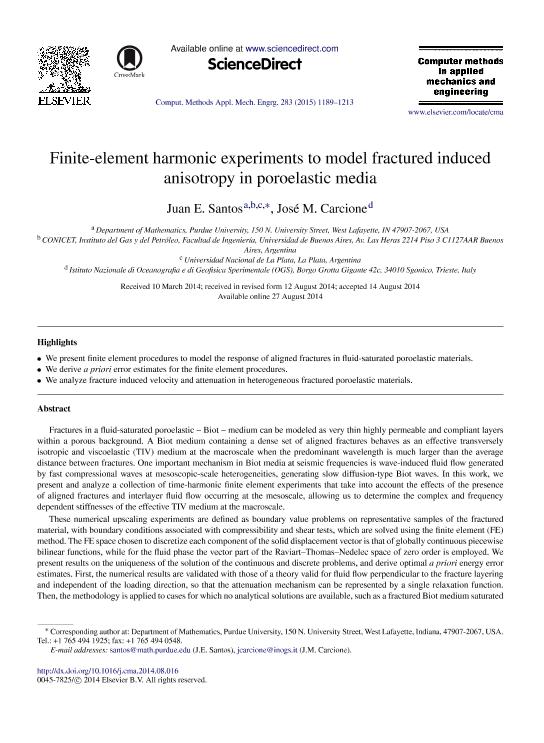Artículo
Finite-element harmonic experiments to model fractured induced anisotropy in poroelastic media
Fecha de publicación:
01/2015
Editorial:
Elsevier
Revista:
Computer Methods in Applied Mechanics and Engineering
ISSN:
0045-7825
Idioma:
Inglés
Tipo de recurso:
Artículo publicado
Clasificación temática:
Resumen
Fractures in a fluid-saturated poroelastic-Biot-medium can be modeled as very thin highly permeable and compliant layers within a porous background. A Biot medium containing a dense set of aligned fractures behaves as an effective transversely isotropic and viscoelastic (TIV) medium at the macroscale when the predominant wavelength is much larger than the average distance between fractures. One important mechanism in Biot media at seismic frequencies is wave-induced fluid flow generated by fast compressional waves at mesoscopic-scale heterogeneities, generating slow diffusion-type Biot waves. In this work, we present and analyze a collection of time-harmonic finite element experiments that take into account the effects of the presence of aligned fractures and interlayer fluid flow occurring at the mesoscale, allowing us to determine the complex and frequency dependent stiffnesses of the effective TIV medium at the macroscale.These numerical upscaling experiments are defined as boundary value problems on representative samples of the fractured material, with boundary conditions associated with compressibility and shear tests, which are solved using the finite element (FE) method. The FE space chosen to discretize each component of the solid displacement vector is that of globally continuous piecewise bilinear functions, while for the fluid phase the vector part of the Raviart-Thomas-Nedelec space of zero order is employed. We present results on the uniqueness of the solution of the continuous and discrete problems, and derive optimal a priori energy error estimates. First, the numerical results are validated with those of a theory valid for fluid flow perpendicular to the fracture layering and independent of the loading direction, so that the attenuation mechanism can be represented by a single relaxation function. Then, the methodology is applied to cases for which no analytical solutions are available, such as a fractured Biot medium saturated with brine and patches of CO2 and a brine saturated sample of uniform background and fractures with fractal variations in their petrophysical properties.
Archivos asociados
Licencia
Identificadores
Colecciones
Articulos(SEDE CENTRAL)
Articulos de SEDE CENTRAL
Articulos de SEDE CENTRAL
Citación
Santos, Juan Enrique; Carcione, Jose M.; Finite-element harmonic experiments to model fractured induced anisotropy in poroelastic media; Elsevier; Computer Methods in Applied Mechanics and Engineering; 283; 1-2015; 1189-1213
Compartir
Altmétricas




